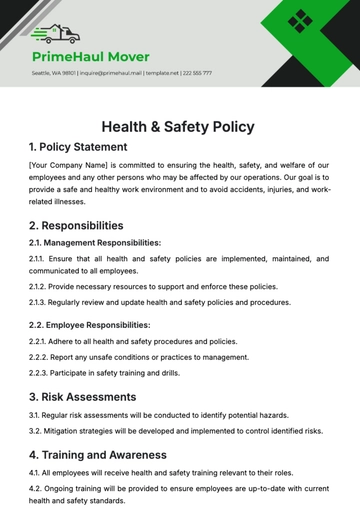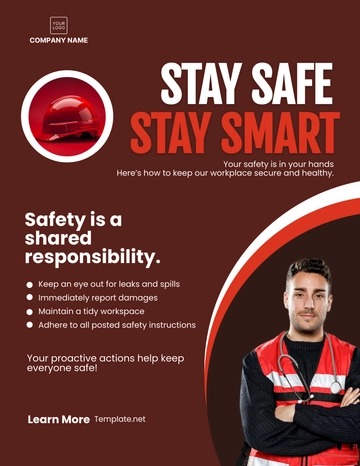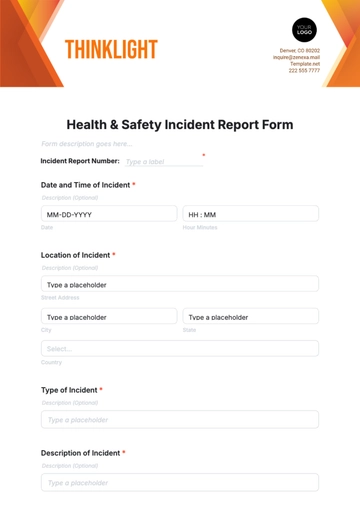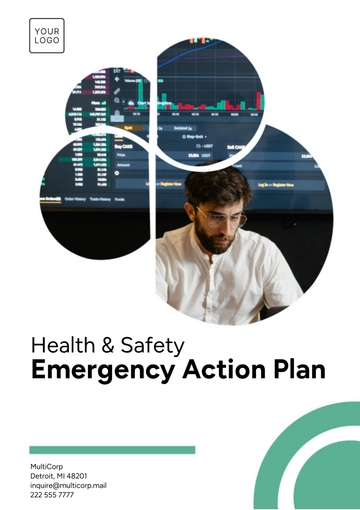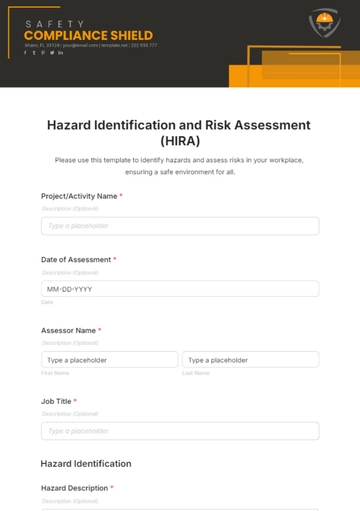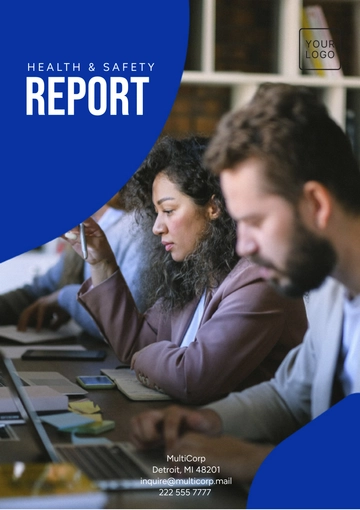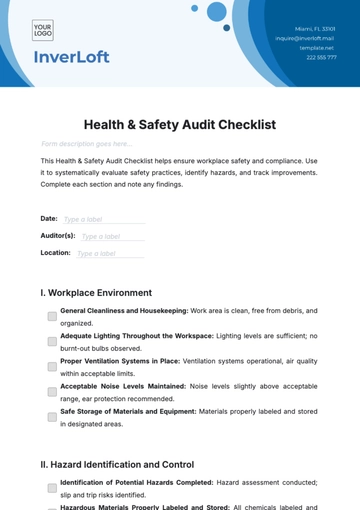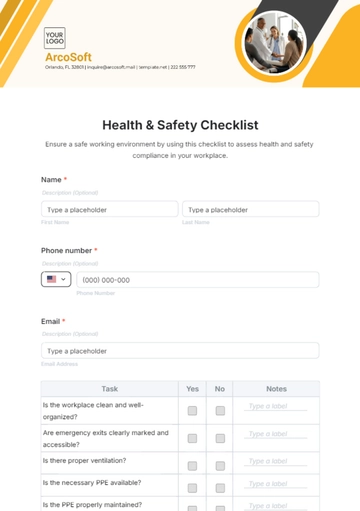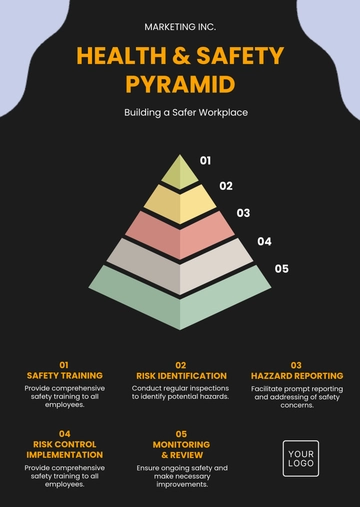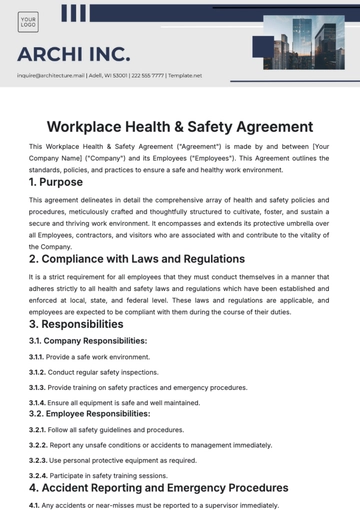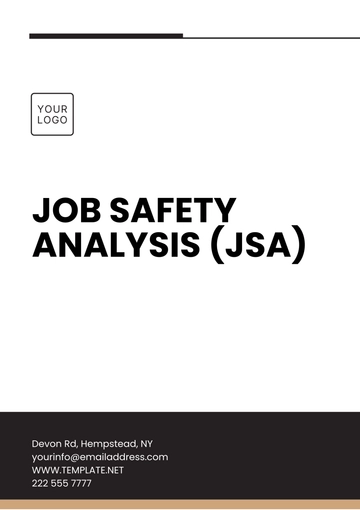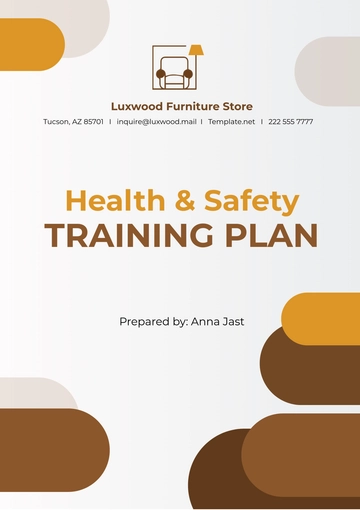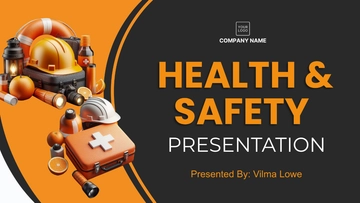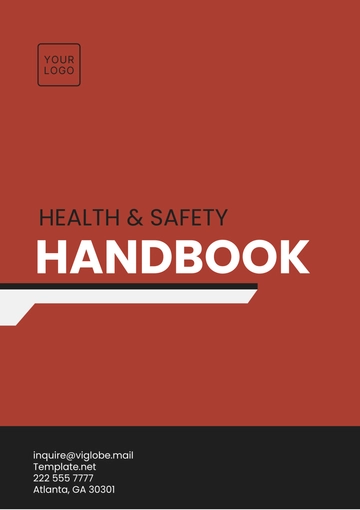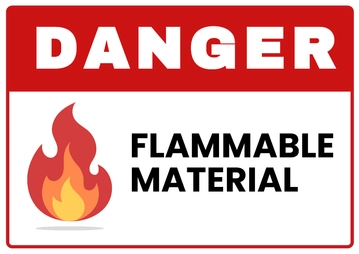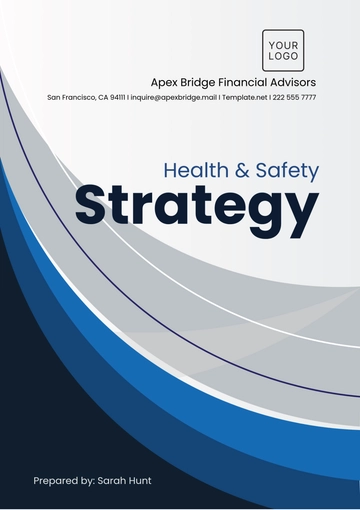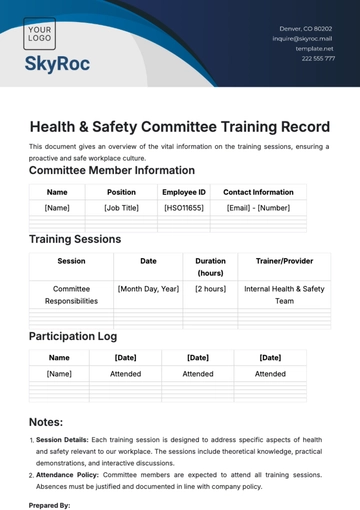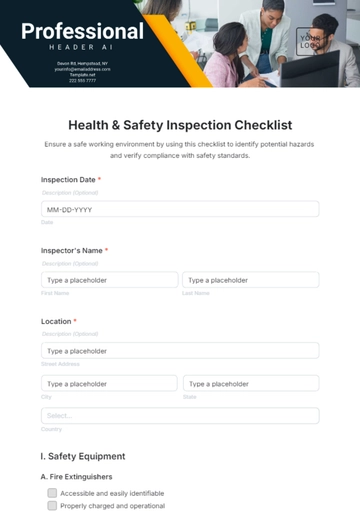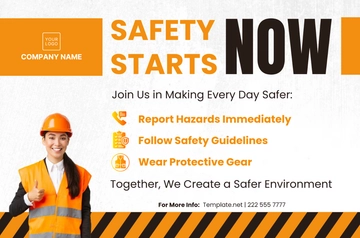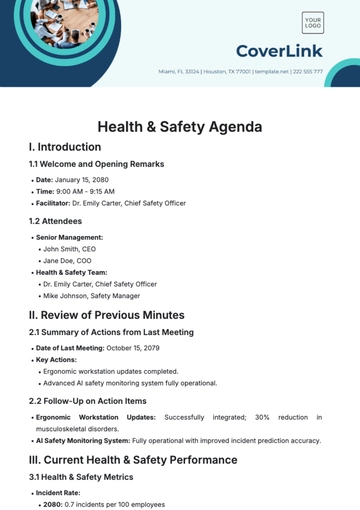Free Health & Safety Project Brief
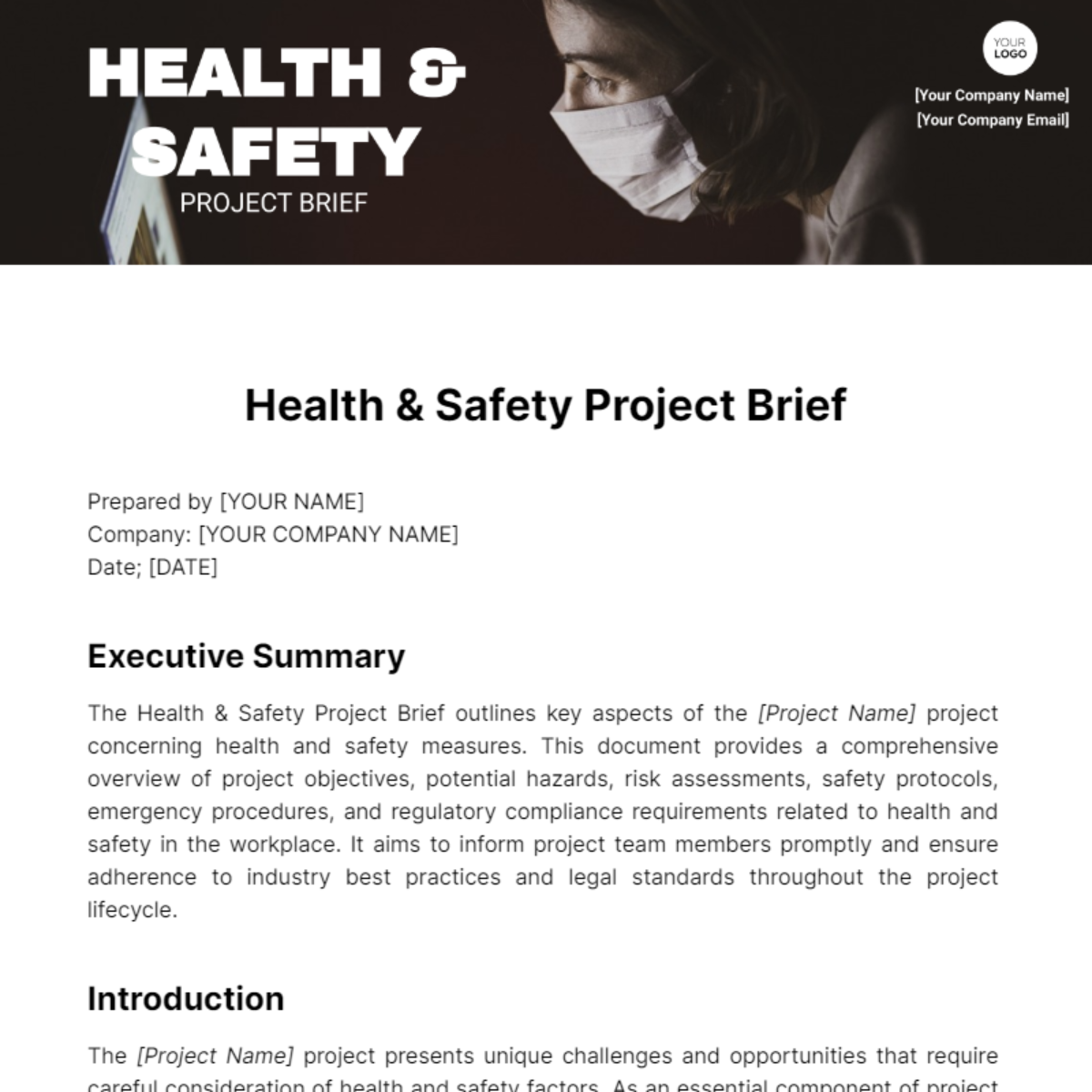
Prepared by [YOUR NAME]
Company: [YOUR COMPANY NAME]
Date; [DATE]
Executive Summary
The Health & Safety Project Brief outlines key aspects of the [Project Name] project concerning health and safety measures. This document provides a comprehensive overview of project objectives, potential hazards, risk assessments, safety protocols, emergency procedures, and regulatory compliance requirements related to health and safety in the workplace. It aims to inform project team members promptly and ensure adherence to industry best practices and legal standards throughout the project lifecycle.
Introduction
The [Project Name] project presents unique challenges and opportunities that require careful consideration of health and safety factors. As an essential component of project management, prioritizing the well-being of all personnel involved is paramount. This Health & Safety Project Brief serves as a foundational document to guide the implementation of robust health and safety measures, fostering a safe and secure working environment for all project stakeholders.
Project Objectives
The primary objectives of the [Project Name] project, concerning health and safety, are detailed below:
Identify Potential Hazards and Risks: Conduct comprehensive assessments to identify potential hazards and risks associated with project activities, equipment, materials, and the work environment. This includes analyzing tasks, equipment usage, chemical exposures, environmental factors, and other pertinent variables to proactively address safety concerns.
Develop and Implement Safety Protocols: Establish robust safety protocols, procedures, and guidelines tailored to the specific needs and circumstances of the project. These protocols encompass a wide range of safety measures, including but not limited to, personal protective equipment (PPE) requirements, safe work practices, emergency procedures, and hazard communication strategies.
Ensure Regulatory Compliance: Ensure strict adherence to regulatory standards and industry best practices pertinent to health and safety in the workplace. This involves staying abreast of applicable laws, regulations, codes, and standards and implementing measures to ensure compliance at all levels of project operations.
Promote Safety Awareness and Accountability: Foster a culture of safety awareness and accountability among all project personnel. This entails providing regular safety training and education, encouraging active participation in safety initiatives, promoting open communication channels for reporting safety concerns and holding individuals accountable for their actions and adherence to safety protocols.
Continuous Monitoring and Improvement: Continuously monitor, evaluate, and improve health and safety practices throughout the project lifecycle. This includes conducting regular safety inspections, audits, and reviews to identify areas for improvement, analyzing safety performance metrics to gauge effectiveness, implementing corrective actions to address deficiencies, and incorporating lessons learned to enhance future safety outcomes.
Emergency Preparedness
Emergency preparedness is integral to maintaining a safe working environment during the [Project Name] project. The following measures are established to mitigate risks and respond effectively to emergencies:
Tailored Emergency Response Plans: We have developed specific plans to address project-related emergencies, outlining clear procedures for various scenarios.
Regular Training and Drills: Project personnel undergo regular training sessions and drills to familiarize themselves with emergency procedures and protocols.
Established Communication Channels: Dedicated communication channels are in place for reporting emergencies and coordinating response efforts.
Provision of Resources and Equipment: Adequate resources and equipment, including firefighting gear and first aid kits, are provided to support emergency response activities.
Regular Review and Updating: Our emergency preparedness plans are regularly reviewed and updated to address evolving risks and circumstances.
Documentation and Reporting
Effective documentation and reporting mechanisms are essential for monitoring and managing health and safety performance throughout the [Project Name] project. The following procedures are established for documenting and reporting safety-related information:
Maintenance of Incident Reporting Systems:
A centralized incident reporting system will be established to document all accidents, near misses, and safety observations promptly.
Each incident will be thoroughly documented, including details such as date, time, location, individuals involved, nature of the incident, and any contributing factors.
Incident reports will undergo a review process to ensure accuracy and completeness before being filed for analysis and action.
Regular Inspection and Auditing:
Scheduled inspections and audits of project activities and facilities will be conducted at regular intervals to identify potential hazards and areas of non-compliance.
Inspection checklists will be developed to systematically assess various aspects of health and safety, including equipment condition, workplace organization, and adherence to safety protocols.
Findings from inspections and audits will be documented, and corrective actions will be assigned to responsible individuals or teams for timely resolution.
Timely Communication of Safety-Related Information:
Safety-related information, including incident reports, inspection findings, and relevant updates, will be communicated promptly to project stakeholders, regulatory authorities, and relevant parties.
Communication channels such as email, meetings, and safety bulletins will be utilized to ensure the timely dissemination of information and facilitate collaboration among stakeholders.
Analysis of Safety Data:
Safety data collected through incident reports, inspections, and audits will be analyzed to identify trends, patterns, and areas for improvement.
Statistical analysis and trend tracking will be conducted to monitor safety performance over time and identify recurring issues or emerging risks.
Findings from safety data analysis will inform decision-making processes and guide efforts to enhance safety performance and prevent future incidents.
Documentation of Corrective Actions:
Any identified safety deficiencies or non-compliance issues will be addressed through documented corrective actions.
Corrective actions will be prioritized based on severity and potential impact on health and safety.
Documentation of corrective actions will include details such as the nature of the issue, proposed solutions, responsible parties, timelines, and verification of implementation.
Follow-up procedures will be established to monitor the effectiveness of corrective actions and verify that identified issues have been adequately resolved.
Continuous Improvement
Continuous improvement is integral to the success of the [Project Name] project, ensuring that health and safety practices evolve to meet changing circumstances and emerging risks. The following specific information outlines how continuous improvement will be implemented:
Feedback Mechanisms: A structured feedback system will be established to solicit input from project personnel regarding health and safety practices and procedures. This will include regular surveys, suggestion boxes, and open-door policies to encourage active participation and engagement from all team members.
Safety Performance Metrics: Key performance indicators (KPIs) related to health and safety will be identified and regularly monitored to assess performance and identify areas for improvement. Metrics may include incident rates, near-miss reports, compliance with safety protocols, and completion of safety training programs.
Corrective and Preventive Actions: Upon identification of safety gaps or issues through performance metrics or feedback mechanisms, corrective and preventive actions will be promptly implemented. This may involve revising procedures, enhancing training programs, upgrading equipment, or redesigning work processes to mitigate risks and prevent future incidents.
Training and Development: Continuous learning and development opportunities will be provided to project personnel to enhance their knowledge and skills related to health and safety. This may include regular safety training sessions, workshops, toolbox talks, and access to online resources and educational materials.
Collaboration and Knowledge Sharing: Collaboration with industry peers, stakeholders, and relevant organizations will be actively pursued to exchange best practices, lessons learned, and innovative solutions related to health and safety. This may involve participating in industry conferences, workshops, and forums, as well as networking with other project teams and organizations facing similar challenges.
Contractual and Legal Compliance
To ensure compliance with health and safety requirements for the [Project Name] project, the following measures are implemented:
Identification of Laws and Regulations: We identify relevant health and safety laws, regulations, and standards.
Integration into Contracts: Health and safety requirements are included in project contracts and agreements.
Regular Review and Updates: Contractual obligations are reviewed and updated to reflect changes in regulations and standards.
Engagement with Legal Counsel and Authorities: We consult legal experts and regulatory authorities to ensure compliance.
Monitoring and Enforcement: Robust monitoring and enforcement mechanisms are established to verify compliance and address any breaches promptly.
Resource Allocation
Effective resource allocation is crucial for supporting the implementation of health and safety measures throughout the [Project Name] project. The following resources are allocated to support health and safety objectives:
Budgetary Allocation:
A dedicated portion of the project budget, approximately 10%, is earmarked for health and safety purposes.
This budget allocation covers the procurement of essential safety equipment such as personal protective equipment (PPE), safety signage, first aid kits, and emergency response tools.
Additionally, funds are allocated for the purchase of training materials, including manuals, videos, and online courses, to ensure comprehensive safety training for all project personnel.
A contingency fund of 5% is also set aside to address any unforeseen safety-related expenses that may arise during the project lifecycle.
Personnel Assignment:
A Health and Safety Officer (HSO) is appointed to oversee all health and safety activities and initiatives throughout the project.
The HSO's responsibilities include conducting risk assessments, developing safety protocols, monitoring compliance with safety regulations, and providing ongoing safety safety training support to project personnel.
In addition to the HSO, each project team is assigned a Safety Coordinator responsible for implementing safety procedures at the operational level and serving as a point of contact for safety-related inquiries or concerns.
Time and Manpower Provision:
Dedicated time slots are allocated within the project schedule for conducting regular safety inspections, audits, and training sessions.
Safety inspections are conducted bi-weekly by the Safety Coordinator, with additional audits scheduled quarterly by the HSO to ensure compliance with safety protocols and regulations.
Quarterly safety training sessions are organized for all project personnel to refresh their knowledge of safety procedures and address any new safety concerns or updates.
Partnerships with External Vendors:
Partnerships are established with reputable external vendors and service providers to supplement internal resources and expertise.
External vendors are contracted for specialized safety services such as hazardous material disposal, industrial hygiene assessments, and emergency response training.
These partnerships ensure access to specialized knowledge and resources, enhancing the project's overall safety capabilities.
Regular Review and Adjustment:
The project's resource allocation for health and safety is subject to regular review and adjustment to address emerging needs and priorities.
Monthly meetings are scheduled with the project management team to assess the effectiveness of current safety measures and identify areas for improvement.
Adjustments to resource allocations are made based on feedback from safety inspections, incident reports, regulatory updates, and industry best practices to continuously enhance safety performance throughout the project lifecycle.
- 100% Customizable, free editor
- Access 1 Million+ Templates, photo’s & graphics
- Download or share as a template
- Click and replace photos, graphics, text, backgrounds
- Resize, crop, AI write & more
- Access advanced editor
Elevate health and safety project planning with Template.net's Health & Safety Project Brief Template. This editable and customizable tool ensures comprehensive risk assessment and mitigation strategies. Seamlessly adjustable within our Ai Editor Tool, it offers flexibility to tailor projects to specific needs. Streamline safety initiatives and ensure compliance with regulatory standards using this comprehensive solution, guaranteeing a secure work environment.

